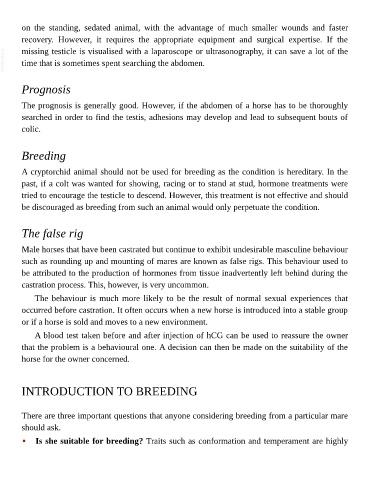Page 918 - The Veterinary Care of the Horse
P. 918
on the standing, sedated animal, with the advantage of much smaller wounds and faster
recovery. However, it requires the appropriate equipment and surgical expertise. If the
VetBooks.ir missing testicle is visualised with a laparoscope or ultrasonography, it can save a lot of the
time that is sometimes spent searching the abdomen.
Prognosis
The prognosis is generally good. However, if the abdomen of a horse has to be thoroughly
searched in order to find the testis, adhesions may develop and lead to subsequent bouts of
colic.
Breeding
A cryptorchid animal should not be used for breeding as the condition is hereditary. In the
past, if a colt was wanted for showing, racing or to stand at stud, hormone treatments were
tried to encourage the testicle to descend. However, this treatment is not effective and should
be discouraged as breeding from such an animal would only perpetuate the condition.
The false rig
Male horses that have been castrated but continue to exhibit undesirable masculine behaviour
such as rounding up and mounting of mares are known as false rigs. This behaviour used to
be attributed to the production of hormones from tissue inadvertently left behind during the
castration process. This, however, is very uncommon.
The behaviour is much more likely to be the result of normal sexual experiences that
occurred before castration. It often occurs when a new horse is introduced into a stable group
or if a horse is sold and moves to a new environment.
A blood test taken before and after injection of hCG can be used to reassure the owner
that the problem is a behavioural one. A decision can then be made on the suitability of the
horse for the owner concerned.
INTRODUCTION TO BREEDING
There are three important questions that anyone considering breeding from a particular mare
should ask.
• Is she suitable for breeding? Traits such as conformation and temperament are highly

